Basel, small and mighty
How this surprising little city sparked optimism about the future of Paris.
I had low expectations for a recent trip to Basel, a small Swiss city that touches both France and Germany. I’d be staying in a venerable old hotel, the genteel sort of thing for which I’m an absolute sucker, but expected to find the city dull and expensive. And while I did bleed euros while there—it was Switzerland, after all—Basel was anything but dull. It was charming, relaxed yet lively, and without any pretense.
The place embodied everything I love about small and mid-sized cities. It had reclaimed most of its lovely center and given it over to people. This pedestrian area could be crossed in about 20 minutes: small enough to feel cohesive and manageable, but big enough to test the political and infrastructural limits of pedestrianization. The center offered lots of dining, nightlife, and cultural options, and was unsurprisingly full of buses, trams, bicycles, and walkers.
But the real sparkling gem of a summer visit to Basel lies just to the east of the center: the magnificent Rhine. My hotel sat directly on its hardened banks, and the staffer who escorted me to my room explained the disorienting slant of the stairs and misalignment of the building’s hallways as a result of the strong current flowing against the building for centuries. The single window in the room opened wide to offer a delightful view of that current, which sparkled brightly in the morning sunshine.
The view also took in an old stone bridge with four arches. It was lined with flags and crossed by trams, almost an archetype of what I imagine an old bridge in old Europe to be. I sat for a while and watched barges, tugs, and other vessels move silently and smoothly under two of the arches. Then, in the early afternoon, I spotted little specks floating downstream under the arch nearest the opposite bank: people, sporadic at first, then more frequently and sometimes in little groups. It was hot during my visit, and this traffic of floating bodies reached its apex sometime in the couple of hours before sunset, which in summer came to that latitude slowly and late.
I took to the bridge to check it out. Most of the floaters were attached to inflated tote bags, which I later learned were called wickelfisch, and which kept their possessions dry so they could dive right into the river after work and float on home—or to one of the many bars and cafés that lined the riverbank. The current moved at a comfortable pace, quickly enough to be fun but slowly enough to be safe and easily swimmable. And the swimmers did look utterly at ease, no hint of effort in the current, no suggestion that the water was cold or polluted or anything but utterly appealing. Indeed, I could see right down into the water, past their legs, sometimes to the stony river bottom. This clarity astonished me, having grown up beside the muddy Mississippi and spent my formative years on an island surrounded by the brackish, no-go Hudson and East River estuaries.
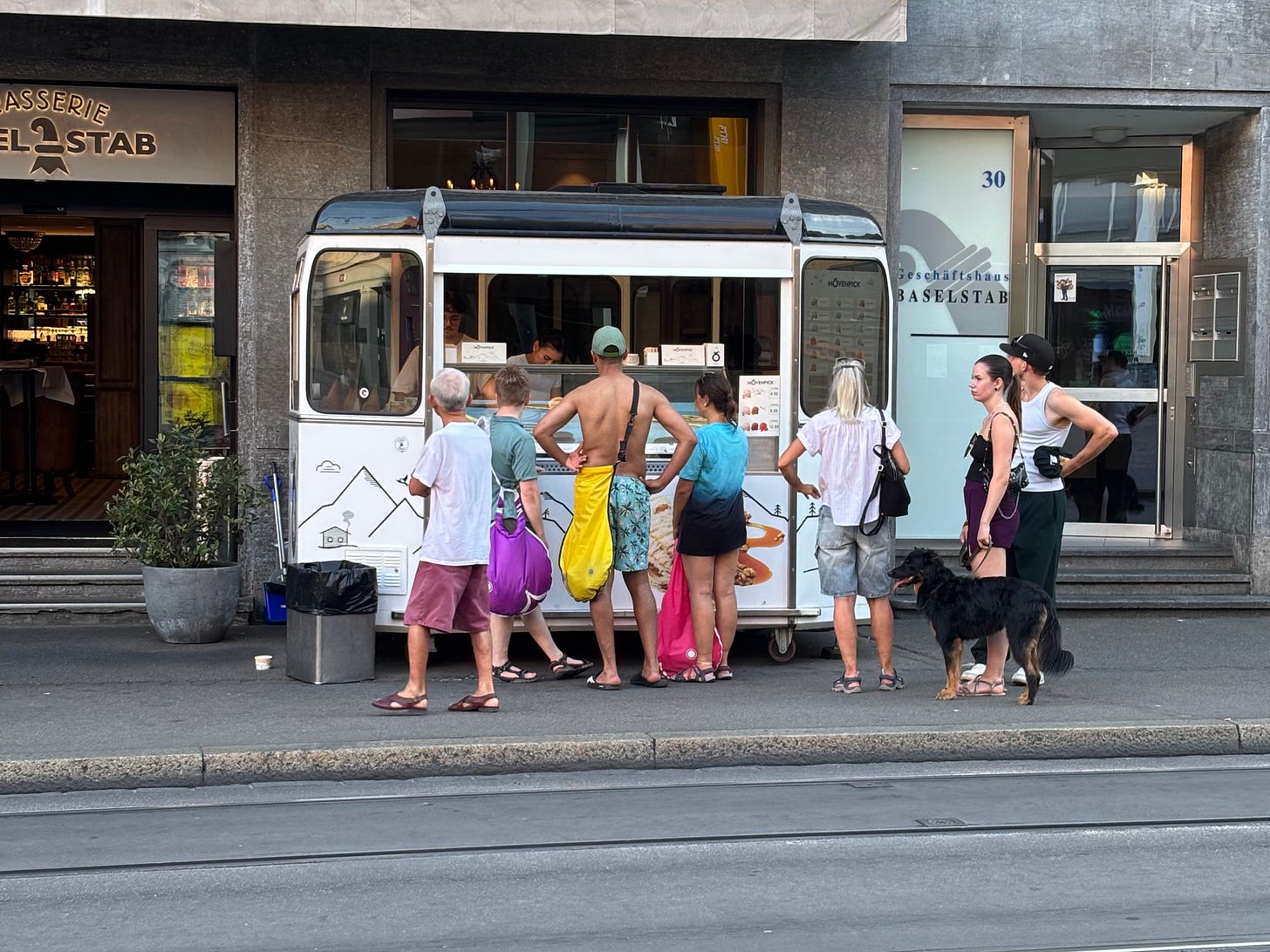
The next day I laced up my running shoes and took to the riverside paths, one of which began right beneath my hotel and ran downstream. It probably carried on right into France—just a mile or two hence—but after a mile I decided to double back. I crossed the river on a broad, modern bridge with enormously wide sidewalks, two-way bike lanes, and just one vehicle lane in each direction, an obvious redesign from its likely original function, which must have been to move as much vehicle traffic as possible, as quickly as possible, between riverbanks.
Whereas buildings and a wall of rock continuously lined the sheer left bank where my hotel was located, the right bank was lower, which brought buildings and city life right up to the waterside. It was idyllic on that morning, perfect and calm, thanks to a lovely, people-friendly urban design that connected the buildings to the water. Cafés and small businesses on the ground floors of ancient stone townhouses faced the narrow cobblestone street that was used almost exclusively by Basel’s abundant bicycles. The street was lined with planted strips overflowing with flowers, trees, and ornamental grasses, which buffered additional seated areas and kiosks serving coffee, drinks, and snacks. Beyond these was a wide sidewalk promenade lined with inviting benches that offered gorgeous views of the river, which gently flowed about 15 or 20 feet below. Finally, stairs or sloping walkways led down to the bank itself. The beautiful embankment felt like a unified space, from the door of each café to the river’s edge, and in Basel’s convivial evenings became occupied with layers of public life of all kinds.
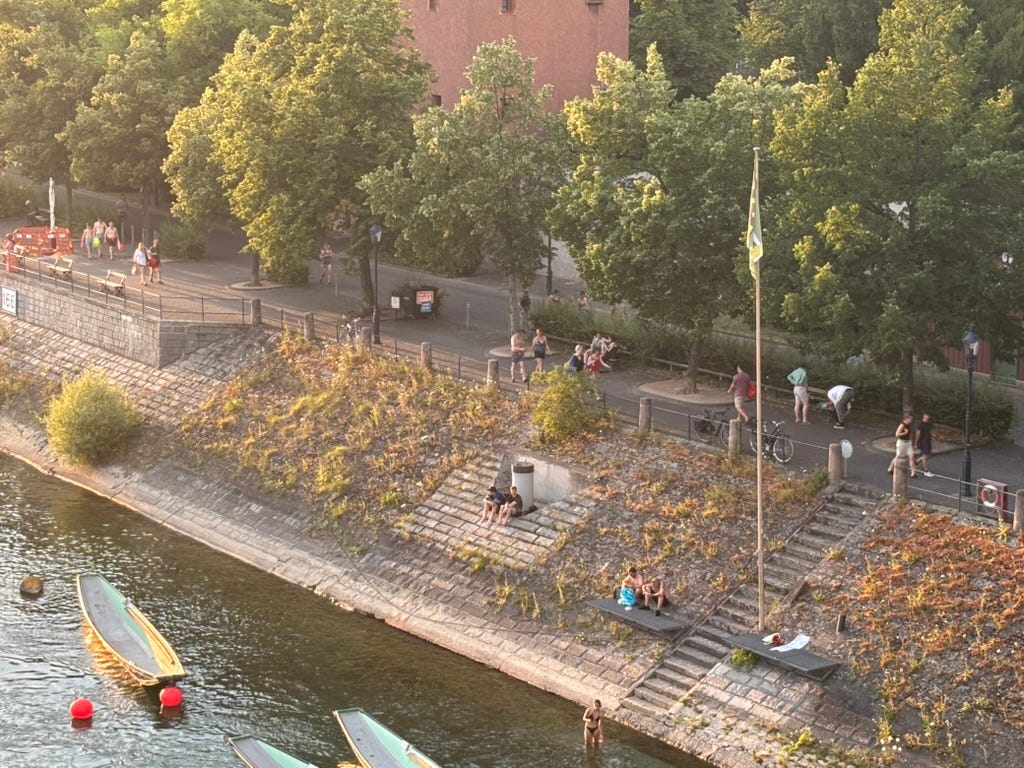
As I carried on upstream, the hardened riverbank gave way to natural beaches as stony as any I’ve seen around the Mediterranean, and just as covered in sunbathers, too. Many sunseekers were topless—this section being out of view of nearby buildings—and all seemed to be having a blast. As I pushed onward, the banks of the river became increasingly naturalized and lush until I finally reached a lock and dam, in a suburban part of town, at which point I crossed on a pedestrian-and-bicycle bridge and turned back.
A rushing little stream joins the mighty Rhine on that opposite side, appearing to tumble right down from a mountain somewhere. As a crossed a gently arched pedestrian bridge over the stream I saw another stony beach formed by the confluence, this one also full of sunbathers and swimmers dipping into the calm waters. It was a divine sight, and I was tempted to join them for relief from my huffing and puffing, but carried on back to the four-arched bridge beside my hotel. By then the light slanted golden, and the evening’s ritual float and riverside party were both in full swing.
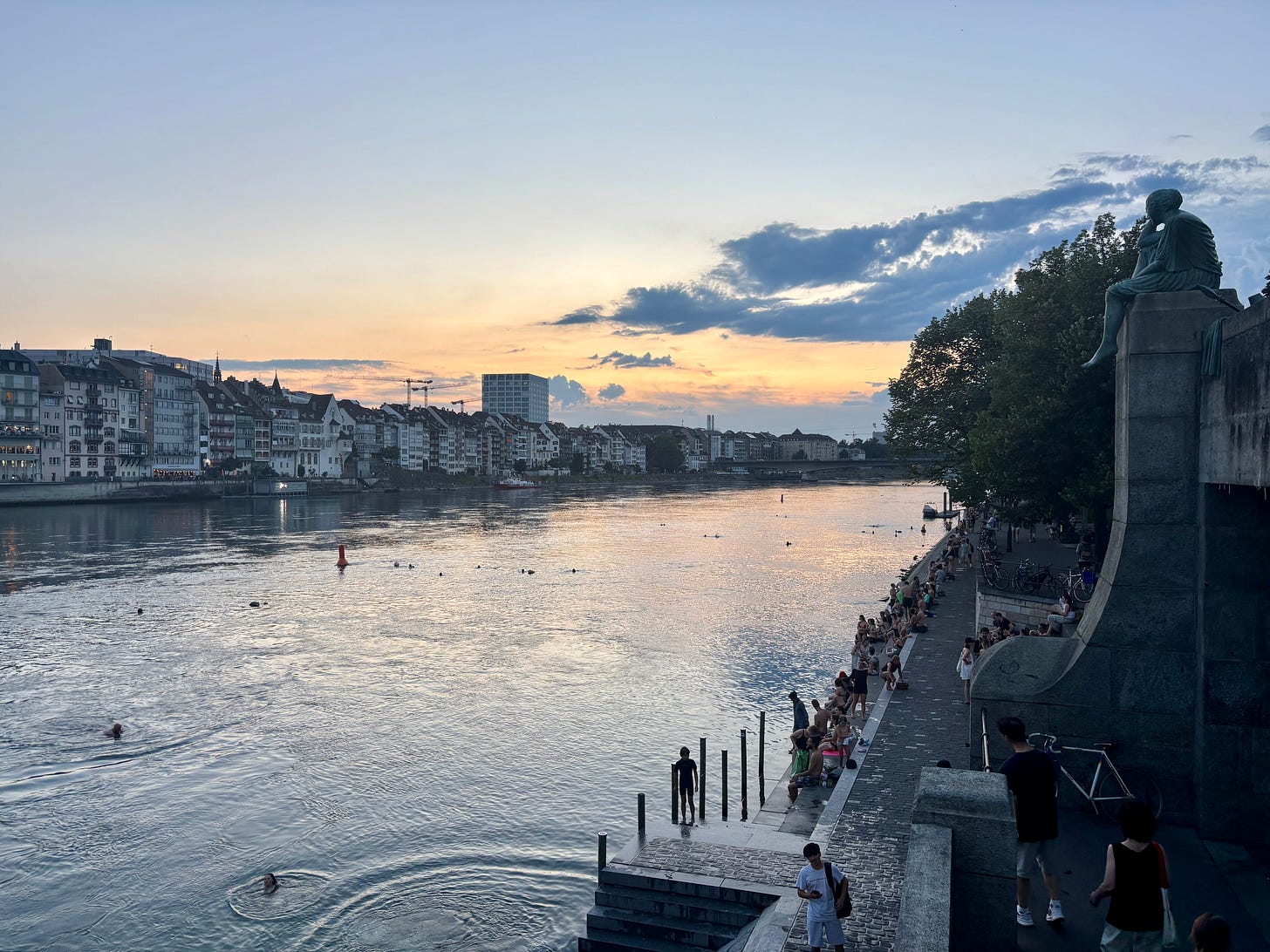
The next day, as I boarded a high-speed train that whisked me back to Paris, I contemplated the vast gap between expectation and reality, which never fails to astonish me when I travel (will I ever learn?!). Basel was as so many Swiss places are: a picture of health and prosperity, tidy but inviting, at once lively and calm. The little city embodied what urban life should be: healthy, practical, convenient, peaceful, prosperous, enviably well-connected, prosperous, and approachably beautiful. It offered no singular spectacular sights and little to appeal to tourists looking for blockbuster experiences. Instead, the city itself was the experience, perfect for a few days of enjoyment in the height of summer. (Basel was also vexingly, maddeningly expensive, which is resolutely not what cities should be—but that’s a rant for another time.)
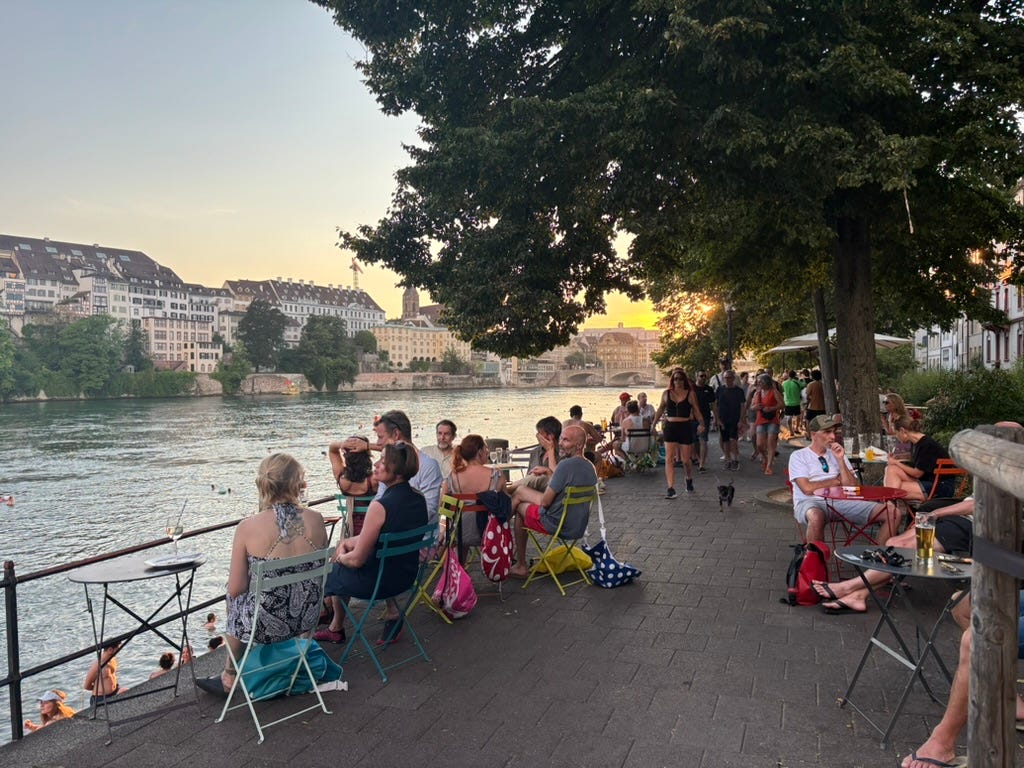
This delightful little gem was also just a few hours from home. With an open mind, what other surprises awaited me within France’s own borders? I was traveling to Nice for an upcoming birthday trip, and wondered if it might, too, offer the same sense of pleasing compactness and simple pleasure. I opened a map and let my mind wander to Nîmes, Montpellier, Toulouse, and other places I’d given little thought.
As I approached Paris, I considered what Basel might have to say to that urban giant. Paris is in an era of transformation, once again reorienting itself to the walkers and bikers who have long roamed its stony streets. Cars have been banished from the lower quays of the Seine, which on weekends now brim to the point of congestion with walkers, runners, rollerbladers, and merrymakers. Bold policies are pedestrianizing streets, reducing the presence and impact of the most polluting vehicles, converting a space-hogging oversupply of street parking to better and more productive use, and reducing traffic through the central quarters. All of it requires courage, political sensitivity, and technical savvy. All of it deserves praise. All of it inspires me.
Still, I wondered if the city couldn’t go further. The Seine in Paris and the Rhine in Basel are two very different rivers. The Seine is smaller, moves faster, and is full of boat traffic. We’re unlikely to see freeform evening floats from Bercy to Trocadéro in my lifetime, but the city has established summer swimming areas in the Seine and some are calling swimming in the canals a climate adaptation imperative. But the Seine is similar to the Rhine in at least one important way: both rivers are the very foundations of the cities they move through. Why can’t we banish vehicles from the noisy and polluted upper quais of the Seine, too, so the burgeoning life of the city above could be stitched to the river below rather than severed by a vehicle sewer?
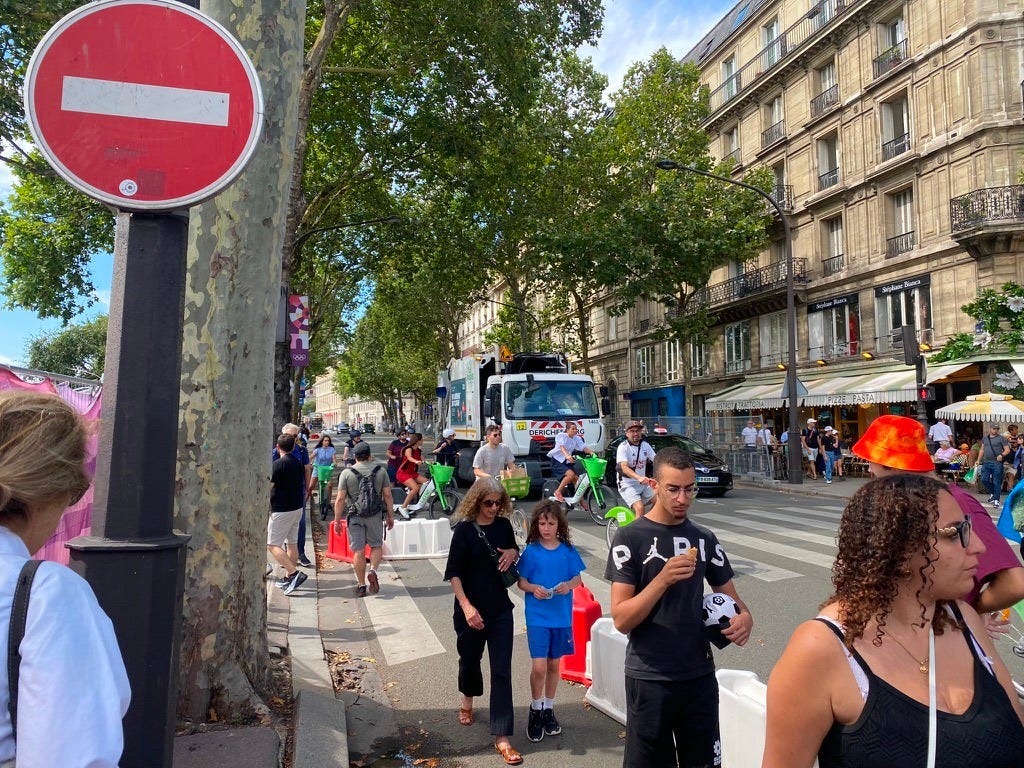
And why, beyond the riverbanks, couldn’t we insist that larger swathes of the city be pedestrianized? Small and medium-sized cities around Europe had pedestrianized or created large low-traffic zones that restrict vehicle movement physically and sometimes by permit. I thought of the Marais, an old and beguiling section of Paris so terribly congested with crowds on the weekends that no sane Parisian would dare visit. Why should anyone need to drive a car into the neighborhood’s narrow and crowded streets on a Saturday or Sunday afternoon?1 Was there any logical, defensible reason why the most beautiful and heavily-visited of the central neighborhoods of a city so comprehensively served by a wide variety of convenient public transportation options should not be given over, finally and definitively, to people?
To hell with the cars, I thought as the train pulled beside the platform at the Gare de Lyon. The best cities, the best places, are always for people first. Basel and Paris were starkly different in size, scale, and complexity, but in the end, it just takes will. Little Basel is an inspiring reminder for big, messy Paris to just keep pushing toward a more livable, sustainable, and joyful future.
Cars are, theoretically, banned from the Marais on the first Sunday of every month as part of the city's Paris Respire program. While this program is laudable, its reality falls far short of its potential. Vehicle access to neighborhoods (including mine, in Montmartre) is limited by flimsy, movable signs, local traffic is still allowed in, and the apparently volunteer guards don't seem to regulate access strictly or consistently. It's a far cry from the automated bollards, gates, and other physical features that are commonplace in low-traffic zones in Basel and across European cities, which limit vehicle access much more effectively. By contrast, the experience of walking through a Respire zone is one of uncertainty: as long as some cars still roam the streets, and street parking is still pervasive, it's hard to feel or see how the streets really belong to us and to take full advantage of the space we've been (stingily and temporarily) “given.”





Take me with you next time, this sounds delightful
Spent a week in Montpellier and Nimes a few years ago and thoroughly enjoyed it. Hope you’re able to get down there and write about it!